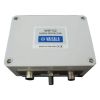Vaisala WSP150 Surge Protector
Features
- Can be used with all Vaisala wind and weather instruments
- Superior three-stage, transient surge protection
- Tolerates up to 10 kA surge currents
- Free ground shipping
- Expedited repair and warranty service
- Lifetime technical support
- More
Overview
The Vaisala WSP150 Surge Protector is a compact transient overvoltage suppressor designed for outdoor use. It can be used with all Vaisala wind and weather instruments. The WSP150 offers three-stage protection against surge currents up to 10 kA entering through the power and signal cables.
Mechanics
The Vaisala WSP150 Surge Protector has four channels, two of which are dedicated to power lines and two for data lines. Each channel uses a three-stage protection scheme as follows: first, there are discharge tubes, then voltage-dependent resistors (VDR), and finally, transient zener diodes. Between each stage, there are either series inductors or resistors. Both differential and common mode protection is provided for each channel: across the wire pairs, against the operating voltage ground, and against the earth. The WSP150 also includes noise filtering against HF and RF interference.
Applications
Vaisala recommends using the WSP150 when wind and weather instruments are installed on top of high buildings or masts and in open grounds, that is, anywhere with an elevated risk of lightning. Also, use the WSP150 if the cable length exceeds 30m or if users have unshielded, open-wire lines.
- (1) WSP150 surge protector
- (1) Adjustable mounting clamp
In The News
Vaisala WXT520: Weather station designed with monitoring systems in mind
The world’s weather is full of surprises. That makes a quality weather station a valuable piece of technology for monitoring systems. Vaisala's WXT520 multiparameter weather station is built with monitoring systems in mind. It monitors six weather parameters in real time, so users have the numbers on an unexpected rain storm or turbulent wind event. It can be a means of understanding weather events that caused a flush of nitrogen into a river or low water levels in a lake. What’s more, with the help of a data logger and telemetry system, it can deliver that information to one’s desk so she can stay dry and keep an eye on the data during a storm. Three core components make up Vaisala’s WXT520 weather station.
Read MoreThree Decades of Research at Acton Lake
A multi-disciplinary team at Miami University, Ohio, has been studying the environmental change at Acton Lake for over three decades. Using three different NexSens buoys over this time, the team has an incredible archive of data that is helping build a picture of Acton’s past, present, and future. Until recently, a NexSens CB-50 buoy was used alongside other environmental monitoring at Acton Lake. In May 2025, the Miami team deployed a new XB-200 buoy , future-proofing their ongoing monitoring using real-time buoy systems. Acton Lake, a small hypereutrophic reservoir in southwest Ohio, covers 2.4km² and has a maximum depth of about 8m. The dam was built in 1956, and the lake has a large agricultural watershed.
Read MoreSource Water Monitoring in Albany, New York: Tracing Water Quality throughout Tributaries
Thousands of US cities pull their drinking water from natural source waters like reservoirs, rivers, and streams, making overall watershed health a key consideration for water providers. In Albany, New York, the Albany Department of Water and Water Supply delivers drinking water to over 100,000 residents as well as monitors and manages the larger drinking water supply watershed. Hannah Doherty, Environmental Specialist at the Albany Department of Water and Water Supply , spends her days working with a small team to monitor the drinking supply and the connected water bodies. Doherty explains, “We’re the first to encounter the water that ends up being the drinking water.
Read More







